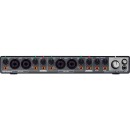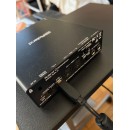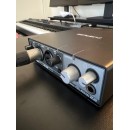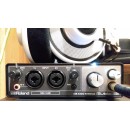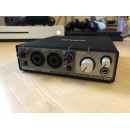Roland Rubix44 Audio Interface: Comprehensive Review
- Four high-quality microphone preamps with XLR/quarter-inch combo inputs.
- Supports 24-bit/192kHz audio resolution for high-fidelity sound.
- MIDI in and out ports for connecting MIDI devices.
- Low-latency performance for real-time monitoring and recording.
- Four balanced TRS outputs for connecting to monitors or other audio equipment.
- USB-powered with optional DC input for additional power stability.
- Hardware compressor/limiter for controlling input dynamics.
- Robust and compact metal construction for durability on the road.
Detailed Specifications, Pros, and Cons of the Roland Rubix44
The Roland Rubix44 Audio Interface is a high-quality, versatile device designed for musicians and producers who need a reliable solution for recording and playback. It features four audio inputs and four audio outputs, which makes it suitable for multichannel recording and live performances. The interface provides pristine sound quality with its 24-bit/192kHz audio resolution, ensuring that every detail of your recordings is captured accurately.
One of the standout features of the Rubix44 is its low-noise mic preamps, which deliver clean and transparent sound. Additionally, it includes MIDI in/out ports, allowing seamless integration with other MIDI devices in your studio setup. The interface also offers a range of connectivity options, including USB, which ensures compatibility with both Windows and Mac operating systems.
The Rubix44 is built with a robust metal casing, which provides durability and reliability for on-the-go musicians. It also features a ground lift switch to help eliminate unwanted noise and hum, making it ideal for use in various environments. With its combination of high-quality audio performance, practical features, and sturdy construction, the Roland Rubix44 is a valuable tool for any audio professional or enthusiast.
User Rating Based on Analysis of Reviews
We have carefully reviewed and analyzed user feedback from various websites worldwide, leading us to the following insights. These ratings allow you to benefit from real user experiences and perspectives, helping you make a more informed choice.
Purchase Value
85% of users were satisfied with the purchase value of the Roland Rubix44 Audio Interface. They found it to be competitively priced for the features and sound quality it offers. Many users appreciated the balance between affordability and high performance, making it an attractive choice for both beginners and professionals seeking a reliable interface without breaking the bank.
15% of users expressed dissatisfaction with the purchase value, often citing that while the product is generally well-priced, there are other options in the market with similar features at a lower price point. A few users also felt that the cost did not justify the additional features they did not personally need or use.
Quality of Materials
90% of users were satisfied with the quality of materials used in the Roland Rubix44. They highlighted the sturdy build and durable construction, which gave them confidence in the product's longevity. The metal chassis and robust knobs were particularly noted for their premium feel and reliability.
10% of users were dissatisfied with the quality of materials, mentioning that while the overall build was solid, some of the buttons and knobs felt a bit flimsy and prone to wear over extended use. A few users also reported minor issues with the USB connectors being less durable than expected.
Sound Quality
92% of users praised the sound quality of the Roland Rubix44, noting the clear, crisp audio output and low-latency performance. Many users were particularly impressed by its ability to provide high-quality recordings across various instruments and vocals, making it a versatile tool for professional studio work.
8% of users were not entirely satisfied with the sound quality, with some noting issues such as slight hiss or background noise at higher gain settings. A few users felt that while the sound quality was good, it wasn't significantly better than cheaper alternatives they had tried.
Ease of Use
88% of users found the Roland Rubix44 easy to use, with a straightforward setup process and intuitive controls. The interface's clear layout and functional design were frequently mentioned as positives, allowing users to quickly get up and running without needing extensive technical knowledge.
12% of users experienced challenges with ease of use, often related to software or driver installation issues. Some found the initial setup confusing, particularly when integrating with certain DAWs, and indicated that the manual could be more detailed or user-friendly.
Driver Stability
80% of users were satisfied with the driver stability of the Roland Rubix44, noting that it performed reliably across different operating systems. Once installed, the drivers provided stable and consistent performance, which was crucial for professional recording environments.
20% of users encountered issues with driver stability, reporting instances of crashes or disconnections during sessions. Some users faced compatibility issues with newer operating systems or found that driver updates were not as frequent as needed, leading to occasional technical difficulties.
Portability
85% of users appreciated the portability of the Roland Rubix44, highlighting its compact size and lightweight design. This made it easy for musicians and producers to transport the interface for live performances or on-the-go recording sessions without much hassle.
15% of users felt that while the interface was portable, it could benefit from a more travel-friendly design. Some users mentioned that the lack of a dedicated carrying case was a drawback, and others desired better protection for the device during transport.
Input and Output Options
90% of users were satisfied with the input and output options available on the Roland Rubix44, praising its multiple XLR and TRS inputs, as well as MIDI connectivity. This versatility allowed users to connect a range of instruments and equipment, catering to diverse recording needs.
10% of users were less satisfied with the input and output options, noting that while the existing ports were adequate, additional digital input/output options would enhance the interface's flexibility. A few users also mentioned that more preamp options would be beneficial.
Aesthetic Design
88% of users liked the aesthetic design of the Roland Rubix44, appreciating its sleek and professional appearance. The modern design was often cited as a positive, with users noting that it looked good in both home studios and professional settings.
12% of users were not fully satisfied with the aesthetic design, feeling that the interface looked somewhat generic or lacked distinctive features that made it stand out visually. Some users suggested that a more varied color scheme or customizable options would improve the overall appeal.
Latency Performance
87% of users were pleased with the low-latency performance of the Roland Rubix44, noting that it allowed for seamless recording and monitoring without noticeable delays. This was particularly important for users working in real-time recording environments.
13% of users experienced latency issues, particularly when using specific software or plugins. While the latency was generally low, some users reported occasional spikes or inconsistency in performance, which could disrupt recording sessions.
Customer Support
78% of users were content with the customer support provided by Roland, finding their responses helpful and timely. Many users appreciated the company's willingness to assist with technical inquiries and resolve issues related to the Rubix44.
22% of users expressed dissatisfaction with customer support, citing slow response times or lack of resolution to their problems. Some users felt that the support team could be more knowledgeable about specific technical issues, leading to longer troubleshooting processes.
Software Bundle
82% of users were satisfied with the software bundle included with the Roland Rubix44, appreciating the additional value it provided. The included DAWs and plugins were often highlighted as useful tools for enhancing the recording experience.
18% of users were not impressed with the software bundle, feeling that the included software was either too basic or not compatible with their preferred setup. Some users also mentioned that the software licenses were limited or that better options were available elsewhere.
Durability
89% of users praised the durability of the Roland Rubix44, noting that it withstood regular use and occasional transport without significant wear and tear. The robust construction was frequently mentioned as a key factor in the product's longevity.
11% of users were concerned about durability, highlighting issues such as minor component failures or wear over time. Some users reported problems with specific parts like knobs or buttons becoming loose or unresponsive after extensive use.
Compatibility
84% of users found the Roland Rubix44 to be highly compatible with various operating systems and DAWs, making it a versatile choice for different setups. The ease of integration with popular software was often highlighted as a significant advantage.
16% of users faced compatibility issues, particularly with newer operating systems or less common DAWs. Some users reported needing additional drivers or workarounds to achieve full functionality, which added complexity to the setup process.
MIDI Functionality
86% of users were satisfied with the MIDI functionality of the Roland Rubix44, appreciating the reliable connectivity and integration with MIDI devices. This feature was particularly valued by musicians who used a variety of digital instruments in their setups.
14% of users experienced issues with MIDI functionality, reporting occasional connectivity problems or delays. Some users felt that the MIDI ports could be more robust, and a few suggested that additional advanced features would enhance usability.
Preamp Quality
91% of users were impressed with the quality of the preamps in the Roland Rubix44, noting their clean sound and low noise floor. Many users found the preamps adequate for both studio and live recording, highlighting their transparency and reliability.
9% of users were not entirely satisfied with the preamp quality, mentioning that while they were generally good, they lacked the warmth or character found in some high-end alternatives. A few users suggested that additional gain options would improve versatility.
Output Volume
83% of users were satisfied with the output volume of the Roland Rubix44, finding it sufficient for both studio monitors and headphones. The ability to deliver clear and loud sound across different outputs was frequently praised.
17% of users experienced issues with output volume, particularly when using certain high-impedance headphones. Some users felt that the maximum volume was lower than expected, requiring external amplification for optimal listening experiences.
Interface Layout
88% of users appreciated the interface layout of the Roland Rubix44, mentioning the intuitive arrangement of controls and clear labeling. The user-friendly design allowed for quick adjustments and easy navigation during recording sessions.
12% of users found the interface layout somewhat cluttered, especially when using the device in low-light conditions. Some users suggested that larger or backlit controls would enhance usability and reduce the chance of errors during live performances.
Noise Isolation
82% of users were satisfied with the noise isolation provided by the Roland Rubix44, appreciating its ability to minimize interference and maintain clean audio signals. This was particularly important for users working in less-than-ideal acoustic environments.
18% of users reported issues with noise isolation, noting that some background noise was still evident in recordings. A few users suggested that additional shielding or improved circuit design could further enhance the interface's performance in this area.
Firmware Updates
75% of users were satisfied with the availability and effectiveness of firmware updates for the Roland Rubix44. They found that updates generally improved functionality and addressed minor issues, contributing to a positive user experience.
25% of users were dissatisfied with the frequency and impact of firmware updates, citing delays in receiving updates or lack of significant improvements. Some users felt that more proactive communication from Roland regarding updates would be beneficial.
Power Supply
80% of users were pleased with the power supply options for the Roland Rubix44, noting the convenience of USB power for portable setups. The ability to operate without an external power source was often mentioned as a key benefit for users on the move.
20% of users experienced issues with the power supply, particularly in situations requiring longer cable lengths or more stable power delivery. Some users reported occasional power-related disconnections or felt that an optional external power supply could enhance reliability.
In this article, we will delve into the detailed specifications, advantages, and disadvantages of the Roland Rubix44 Audio Interface. We aim to provide a thorough examination to help you understand its performance and features.
Pros:
- High-quality 24-bit/192kHz audio resolution for professional sound.
- Four inputs and four outputs, providing flexibility for various recording setups.
- MIDI I/O for connecting external MIDI devices.
- Sturdy metal construction ensures durability and reliability.
- Compatible with Windows, macOS, and iOS, offering versatile connectivity options.
- Direct monitoring feature allows for zero-latency monitoring during recording sessions.
Cons:
- Limited software bundle compared to some competitors.
- Lacks onboard DSP effects, which may require additional software for processing.
- No digital input/output options such as S/PDIF or ADAT.
- Not as compact as some other portable audio interfaces, which may be a consideration for mobile setups.
- Power supply required for iOS connectivity, limiting portability when used with mobile devices.
General
| Channels of I/O | 4 Input / 4 Output |
|---|---|
| Built-In DSP | Yes |
| Maximum Sampling Rate | 192 kHz / 24-Bit |
| Number of Microphone Inputs | 4 |
| Built-In Microphone |
The Channels of I/O specification indicates the number of input and output channels available on the Roland Rubix44. With 4 input and 4 output channels, this audio interface is well-suited for multi-track recording and playback. This means users can connect multiple instruments or microphones simultaneously and manage their signals independently, making it ideal for both home studios and professional setups.Show More
Built-In DSP refers to the presence of digital signal processing capabilities within the audio interface. In the case of the Rubix44, it is equipped with built-in DSP, which allows for real-time effects processing without the need for external software. This feature can enhance audio quality and provide a range of effects, such as reverb or compression, during recording or playback, making it a versatile tool for musicians and producers.
The Maximum Sampling Rate of 192 kHz / 24-Bit indicates the highest quality of audio recording and playback that the Rubix44 can handle. A higher sampling rate and bit depth result in a more detailed and dynamic sound, capturing nuances that might be lost at lower settings. This makes the interface suitable for high-fidelity audio applications, ensuring that recordings are as close to the original sound as possible.
Number of Microphone Inputs specifies that the Rubix44 features 4 dedicated microphone inputs. This allows users to connect multiple microphones for recording vocals or instruments simultaneously. The availability of multiple inputs is beneficial for bands or situations where various sound sources need to be captured at once, providing flexibility in recording arrangements.
The Built-In Microphone option in the Rubix44 indicates that there is no integrated microphone included in the device. While this may seem limiting, it allows users to choose and connect their preferred microphones, ensuring that they can achieve the desired sound quality and character for their recordings. This flexibility is essential for professional audio production, where specific microphone choices can significantly impact the final result.
Signal Processing
| Gain/Trim Range | Line Inputs: -44 to +4 dBu Mic Inputs: -60 to -12 dBu |
|---|
Gain/Trim Range refers to the adjustable range of amplification available for the audio signals received by the Rubix44 audio interface. This feature is crucial for ensuring that incoming audio is at the appropriate level for processing. The specified ranges for line inputs and mic inputs indicate how much the signal can be boosted or attenuated.Show More
For the line inputs, the gain/trim range of -44 to +4 dBu means that users can adjust the signal level from a significantly low level (-44 dBu) up to a standard operating level (+4 dBu). This flexibility allows for precise control over the audio feed from various sources, ensuring optimal signal levels for recording or mixing.
On the other hand, mic inputs have a gain/trim range of -60 to -12 dBu, which is tailored for microphones. This range is important for accommodating different types of microphones and their output levels. By allowing for a wider adjustment range, users can achieve a clean and clear sound without distortion, even when using low-sensitivity microphones.
Connectivity
| Analog Audio I/O | 2x Combo XLR-1/4" TRS Mic Input 2x Combo XLR-1/4" TRS Mic/Line Input 1x 1/4" TRS Headphone Output 4x 1/4" TRS Balanced Line Output |
|---|---|
| Digital Audio I/O | |
| Host Connection | 1x USB-B |
| Host Connection Protocol | USB 2.0 |
| USB (Non-Host) | |
| Sync I/O | |
| Network I/O | |
| MIDI I/O | 1x DIN 5-Pin Input 1x DIN 5-Pin Output |
Analog Audio I/O: The analog audio input and output specifications indicate the types and numbers of connections available on the Rubix44. It features two combo XLR-1/4" TRS mic inputs, which allow users to connect either microphones or line-level devices, providing versatility for various recording scenarios. Additionally, there are four balanced line outputs for sending audio to external devices, ensuring high-quality sound transmission. The headphone output allows for direct monitoring, making it easier to listen to audio in real-time during recording or playback.Show More
Digital Audio I/O: The absence of digital audio input and output means that the Rubix44 does not support digital audio connections such as optical or coaxial. This limitation might affect users who prefer to work with digital audio signals, but the interface is primarily designed for analog use, making it suitable for many traditional studio setups.
Host Connection: The Rubix44 connects to computers via a USB-B port, which is a standard connection type for audio interfaces. This allows for easy integration with various operating systems and DAWs. The USB 2.0 protocol ensures reliable data transfer rates, which is crucial for maintaining audio quality during recording and playback.
USB (Non-Host): The Rubix44 does not support USB connections for devices that are not hosts, such as USB microphones or other peripherals. This feature helps to keep the interface streamlined for its core function of connecting to a computer.
Sync I/O: The lack of sync input and output means that the Rubix44 does not support synchronization with other digital devices, which may limit its use in complex setups involving multiple devices that require clock synchronization.
Network I/O: The absence of network I/O indicates that the Rubix44 does not support audio over network protocols, such as Dante or AES67. This feature is generally required for larger audio networks but may not be necessary for smaller setups.
MIDI I/O: The inclusion of a MIDI input and output via DIN 5-pin connectors allows the Rubix44 to interface with MIDI devices, such as keyboards or controllers. This feature is beneficial for users who want to integrate MIDI data with their audio recordings, providing a complete solution for both audio and MIDI production.
Performance
| Maximum Input Level | Line Inputs: +18 dBu Mic Inputs: +2 dBu |
|---|---|
| Headphone Output Power | 20 mW per Channel into 47 Ohms |
| Impedance | Headphone Outputs: 47 Ohms Hi-Z Inputs: 500 Kilohms Line Inputs: 15 Kilohms Mic Inputs: > 4 Kilohms (Balanced) Outputs: 2 Kilohms (Unbalanced) |
| Dynamic Range | A/D Converters: 104 dB D/A Converters: 109 dB |
| THD+N | -94 dBu |
Maximum Input Level refers to the highest level of audio signal that can be processed by the interface without distortion. For the Rubix44, the maximum input level for line inputs is +18 dBu, which indicates it can handle strong line-level signals typically produced by instruments or mixers. Mic inputs, on the other hand, have a lower maximum input level of +2 dBu, suitable for capturing weaker signals from microphones. Understanding these levels is crucial for ensuring optimal audio quality without clipping or distortion.Show More
Headphone Output Power indicates the amount of power that the interface can deliver to connected headphones. The Rubix44 provides 20 mW per channel into a 47-ohm load, which is sufficient for driving most studio headphones effectively. This specification is important for users who need to monitor audio accurately during recording or playback, ensuring clear sound reproduction without requiring excessively high volume levels that could damage hearing over time.
Impedance is a measure of resistance in an electrical circuit and affects how components interact with each other. The Rubix44 features various impedance levels for its outputs and inputs, such as 47 Ohms for headphone outputs and 500 Kilohms for Hi-Z inputs. Lower impedance values are typically suited for dynamic microphones and lower-impedance devices, while higher values are beneficial for passive instruments, maintaining signal quality and preventing loss of audio clarity.
Dynamic Range measures the range between the smallest and largest signal levels that the audio interface can handle without distortion. The Rubix44's A/D converters have a dynamic range of 104 dB, while the D/A converters boast a slightly better dynamic range of 109 dB. A higher dynamic range allows for greater detail in audio recordings, enabling the capture of both quiet and loud sounds without losing fidelity, which is essential for professional audio production.
THD+N stands for Total Harmonic Distortion plus Noise, a specification that indicates the audio interface's fidelity. The Rubix44 achieves a THD+N rating of -94 dBu, meaning it can reproduce audio with minimal distortion and noise interference. Lower values in this specification are desirable, as they reflect a cleaner signal path, which is crucial for achieving high-quality sound in recordings and playback.
Digital Audio
| Sample Rates | 44.1 / 48 / 96 / 192 kHz (AD/DA Conversion) |
|---|---|
| Bit Depths | 24-Bit |
Sample Rates are crucial in determining the quality of audio recordings. The Rubix44 supports sample rates of 44.1 kHz, 48 kHz, 96 kHz, and 192 kHz for both analog-to-digital (AD) and digital-to-analog (DA) conversion. Higher sample rates allow for more detailed audio capture, resulting in clearer sound reproduction. For instance, a sample rate of 192 kHz can provide a more accurate representation of audio frequencies, making it suitable for professional recordings and high-fidelity music production.Show More
Bit Depth refers to the number of bits used to represent each audio sample. The Rubix44 features a bit depth of 24-bit, which significantly enhances the dynamic range of audio. This means it can capture softer sounds without distortion and manage louder sounds without clipping. A higher bit depth allows for a more nuanced representation of audio, making it ideal for recording and mixing in professional settings where audio fidelity is paramount.
Audio Storage & Playback
| Media/Memory Card Slot |
|---|
The Media/Memory Card Slot feature indicates whether the Roland Rubix44 Audio Interface is equipped with a dedicated slot for inserting memory cards. In this case, the absence of a card slot means that users cannot directly record or store audio files on external memory cards. This limitation suggests that recordings will need to be managed via a connected computer or other storage devices, which could influence workflow and portability for users who prefer standalone recording options.Show More
Having no media or memory card slot may streamline the interface's design, focusing on connectivity and sound quality without additional hardware complexity. However, it also implies that users must rely on their computers for storage and processing, which may not be ideal for those seeking a more mobile or self-contained setup. Overall, this specification highlights the Rubix44's orientation towards professional audio production environments where a computer is typically part of the recording infrastructure.
Compatibility
| OS Compatibility | Windows 7 Windows 8 Windows 8.1 Windows 10 macOS 10.10 or Later 9 or Later |
|---|---|
| Mobile App Compatible | |
| Mobile Device Compatibility | iPad iPhone |
OS Compatibility: The Rubix44 audio interface is designed to work seamlessly with a variety of operating systems, including Windows 7, 8, 8.1, and 10, as well as macOS versions 10.10 and later. This wide range of compatibility ensures that users can integrate the device into their existing setups without worrying about software conflicts or installation issues. Having support for multiple operating systems increases the versatility of the device, making it suitable for both Windows and Mac users.Show More
Mobile App Compatibility: The Rubix44 does not come with a dedicated mobile app for control or monitoring, which means that users will have to rely on their computer systems for functionality. While this may limit some mobile-centric features, it also simplifies the interface and reduces potential issues that can arise from using a mobile app. As a result, users will have a more stable and reliable experience when connecting to their DAWs or recording software.
Mobile Device Compatibility: This audio interface is compatible with iPad and iPhone devices, allowing users to connect their mobile devices for recording and playback. This feature is particularly beneficial for musicians and producers who want to use their mobile devices as part of their creative workflow. It enables greater flexibility and portability, as users can easily record high-quality audio on the go without needing a full computer setup.
Power
| Power Requirements | AC/DC Power Adapter (Included) |
|---|
The Power Requirements specification indicates the type of power source needed for the Roland Rubix44 Audio Interface to operate effectively. This device comes with an AC/DC power adapter included, which ensures that users can easily connect it to a standard electrical outlet. The requirement for an adapter means that the interface is designed to provide a stable and consistent power supply, essential for high-quality audio processing and performance.Show More
Having an included power adapter is particularly beneficial for users who may be using the device in various settings, such as studios or live performances, as it eliminates the need to purchase a separate power source. Additionally, the use of AC/DC power helps to minimize noise interference, which can be critical in maintaining audio clarity and fidelity. Overall, reliable power requirements contribute to the device's performance, ensuring that it operates smoothly during recording or playback sessions.
Physical
| Dimensions | 12.2 x 6.5 x 1.8" / 310 x 165 x 46 mm |
|---|---|
| Weight | 3.9 lb / 1.8 kg |
The Dimensions of the Roland Rubix44 Audio Interface are specified as 12.2 x 6.5 x 1.8 inches (310 x 165 x 46 mm). These measurements indicate the physical size of the device, which is important for users who need to consider space constraints in their studio or workspace. A compact design can facilitate portability, making it easier to transport for mobile recording or live performances. The dimensions also influence how the interface can be integrated into existing setups, such as fitting on desks or in rack mounts.Show More
The Weight of the Rubix44 is 3.9 lbs (1.8 kg), which contributes to its overall portability. A lighter audio interface is generally easier to carry, beneficial for musicians and audio engineers who travel frequently. However, weight can also affect stability; a heavier device might be less prone to movement during use. Understanding the weight helps users assess whether the interface meets their needs for travel and ease of use in various environments.
Packaging Info
| Package Weight | 6.5 lb |
|---|---|
| Box Dimensions (LxWxH) | 15.1 x 9.7 x 5.4" |
Package Weight: The weight of the Roland Rubix44 audio interface is 6.5 lb. This measurement is important for users who may need to transport the device frequently. A lighter weight can enhance portability and ease of use for musicians, audio engineers, or anyone working in different locations, such as studios or live settings. The weight also impacts shipping costs and handling considerations.Show More
Box Dimensions (LxWxH): The dimensions of the box, measuring 15.1 x 9.7 x 5.4 inches, provide insight into the physical size of the packaging. This information is useful for storage and transportation, as it indicates how much space the product will occupy. Knowing the box dimensions can also assist in planning for shelf space or fitting the product into existing gear cases, ensuring that users can easily manage their equipment.
Customer Images
Customer Questions
How do I connect the Roland Rubix44 to my computer?
To connect the Roland Rubix44 to your computer, use the included USB cable to connect the USB port on the Rubix44 to an available USB port on your computer. Ensure that the interface is powered on and that your computer recognizes the device.
Why is there no sound coming from my speakers when using the Rubix44?
Ensure that your speakers are connected to the correct outputs on the Rubix44, typically the main outputs. Check the output volume levels on both the Rubix44 and your computer. Also, make sure the correct audio output device is selected in your computer's sound settings.
How can I install the Rubix44 drivers on my computer?
Visit the Roland website and navigate to the support section. Download the latest drivers for the Rubix44 compatible with your operating system. Follow the installation instructions provided, and restart your computer if prompted.
How do I set up the Rubix44 in my DAW?
Open your DAW and go to the audio preferences or settings. Select the Rubix44 as your input and output audio device. Ensure that the sample rate and buffer size are configured according to your project's needs.
What should I do if my Rubix44 is not being recognized by my computer?
Check the USB connection and try a different USB port or cable if necessary. Ensure that the Rubix44 is powered on and that the drivers are properly installed. If the issue persists, try rebooting your computer or updating your operating system.
Why am I experiencing latency issues with the Rubix44?
Check the buffer size settings in your DAW. A lower buffer size reduces latency but may increase CPU usage. If latency persists, ensure that your computer's performance settings are optimized for audio processing and that no other programs are consuming excessive resources.
How do I update the firmware on my Rubix44?
Visit the Roland website, download the latest firmware update for the Rubix44, and follow the instructions provided. Typically, this involves connecting the Rubix44 to your computer via USB and using the firmware update tool to install the new firmware.
How can I resolve distortion or crackling audio issues with the Rubix44?
Ensure that the input gain levels are set appropriately, avoiding clipping. Check your DAW settings for sample rate mismatches. Additionally, verify that your cables and connections are secure and in good condition.
Can the Rubix44 be used with an iPad or other mobile devices?
Yes, the Rubix44 can be used with an iPad or other mobile devices. You will need a compatible USB adapter or camera connection kit to connect the interface to your mobile device. Ensure the interface is powered, as mobile devices may not provide enough power.
How do I perform a factory reset on the Rubix44?
To perform a factory reset on the Rubix44, power off the device. Then, hold down the INPUT 1 and INPUT 2 buttons while powering it back on. Release the buttons once the LEDs start flashing. This will reset the interface to its default settings.

